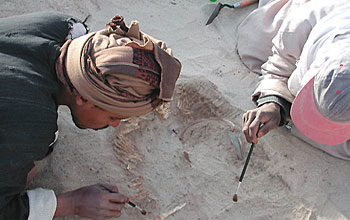Media Advisory 08-024
NSF Launches Special Report to Highlight Differences and Similarities Between the Worlds of Science and Indiana Jones
May 21, 2008
This material is available primarily for archival purposes. Telephone numbers or other contact information may be out of date; please see current contact information at media contacts.
As audiences around the world eagerly await the opening of the fourth installment in the Indiana Jones film saga on May 22, the National Science Foundation (NSF) has launched a special report on its Web site that illustrates where the real world of archaeology diverges from the "reel" world, as well as where they infrequently intersect.
While no one expects that the fictional Indiana Jones, the hero of four swashbuckling tales of adventure, to resemble real scientists, archaeologists concede that parallels do exist with their work.
NSF-supported archeologists do discover "lost cities." They try to figure out what happened to "vanished civilizations" and whether what caused their collapse may have relevance to contemporary problems. They seek rare and precious artifacts that tell important stories about the past, even if those artifacts are minute snails and the scrapings of ancient teeth and not golden idols. They "deal with Native peoples," though with respect, as partners in the process of learning about the past, rather than with weapons. And certainly, as is jokingly noted in the latest Indian Jones adventure, teaching is an important part of what they do.
"We focus on anthropological archaeology," says John Yellen, NSF's program director for archaeology and archometry in the Social, Behavioral & Economic Science directorate. "We're trying to understand broad principles of human behavior."
The new special report features tales of the scientific work being done by NSF-funded archaeologists working as far afield as the Aleutians and Egypt, China and the deserts of Mexico or as close as Mississippi.
It may be found at http://www.nsf.gov/news/special_reports/archaeology/index.jsp.
-NSF-
Media Contacts
Peter West, NSF, (703) 292-7761, email: pwest@nsf.gov
Program Contacts
John E. Yellen, NSF, (703) 292-8759, email: jyellen@nsf.gov
Anna M. Kerttula de Echave, NSF, (703) 292-7432, email: akerttul@nsf.gov
Related Websites
Archaeology From Reel to Real: http://www.nsf.gov/news/special_reports/archaeology/index.jsp
The U.S. National Science Foundation propels the nation forward by advancing fundamental research in all fields of science and engineering. NSF supports research and people by providing facilities, instruments and funding to support their ingenuity and sustain the U.S. as a global leader in research and innovation. With a fiscal year 2023 budget of $9.5 billion, NSF funds reach all 50 states through grants to nearly 2,000 colleges, universities and institutions. Each year, NSF receives more than 40,000 competitive proposals and makes about 11,000 new awards. Those awards include support for cooperative research with industry, Arctic and Antarctic research and operations, and U.S. participation in international scientific efforts.
Connect with us online
NSF website: nsf.gov
NSF News: nsf.gov/news
For News Media: nsf.gov/news/newsroom
Statistics: nsf.gov/statistics/
Awards database: nsf.gov/awardsearch/
Follow us on social
Twitter: twitter.com/NSF
Facebook: facebook.com/US.NSF
Instagram: instagram.com/nsfgov



